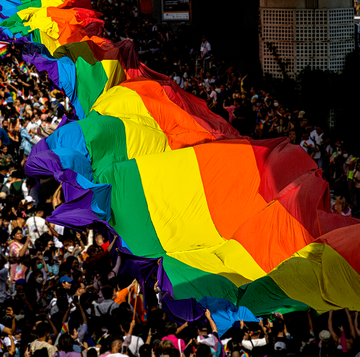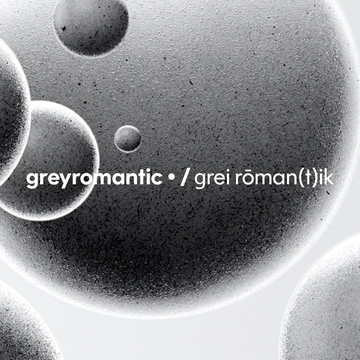The last couple decades have seen widespread acceptance of the singular pronoun “they,” and terms like “agender,” “gender non-conforming,” and “gender-expansive.” The queer lexicon continues to grow everyday to encapsulate different experiences. Up until recently, FTM and MTF, acronyms that mean “female-to-male” and “male-to-female,” were used widely in queer circles to categorize transness. Today, those terms have largely been replaced by the more precise and affirming AFAB and AMAB, meaning “assigned female/male at birth,” which can be applied to anyone regardless of gender identity.
And while these descriptors are used primarily in queer and gender-expansive spaces, they’re inching their way into the mainstream, giving people of all orientations new ways to explore their gender identity.
Ready to expand your own gender vocabulary? Read on for everything you need to know about the terms AFAB and AMAB.
What does AFAB/AMAB mean?
AFAB/AMAB stands for “assigned female/male at birth” and refers to the moment a person, usually a medical professional, determines the sex of a baby by examining the genitalia, either in an ultrasound or once the child is born.
“When we talk about assigned female/male at birth, the focus is on the assignment. It’s the fact that something is being assigned to you from without,” says Lucie Fielding, sex educator and author of Trans Sex: Clinical Approaches to Trans Sexualities and Erotic Embodiments.
Terms like MTF and FTM are now thought to be insufficient because they “assume that you started out in one gender,” Fielding says. That if you were deemed “biologically male” or “biologically female” at birth, your gender at one point aligned with that assignment.
Claudia Johnson, a relationship, intimacy, and sex therapist, says this distinction is important because “biological sex is one thing, and gender identity and expression is another.”
Fielding also notes that “[MTF and FTM] cut out non-binary gender identities or agender identities,” while AFAB and AMAB apply to almost everyone regardless of how you grew to identify or express your gender.
Related terms:
Where did AFAB/AMAB originate?
According to Johnson, AFAB and AMAB are newer iterations of CAMAB (coercively assigned male at birth), “a term coined by trans women to express the violence of being forced against their will into a male gender role.” CAMAB appealed to intersex activists who also related to the term and adopted it for themselves. From there, trans folks developed AFAB/AMAB.
Johnson says these terms are the product of an intentional shift in the last 16 years away from binary restraints. “There has been an investment in studying gendered linguistics without focusing on the binary, or at least to move away from gender normativity,” she says.
According to Fielding, AFAB/AMAB is hardly a final destination within trans, non-binary, and gender-expansive communities.
“Some folks are really comfortable with [AFAB and AMAB] and really like them, and some of us are already looking for the next term that will be more nuanced and that will allow more people to feel seen and heard and held,” she says.
Should I use AFAB/AMAB? How is it different from “cis”?
Technically, just about everyone falls into AFAB or AMAB. “And on top of that you can identify as trans, non-binary, cis,” agender, or anything else, Johnson says.
But AFAB/AMAB itself is not a gender. As Fielding says, it’s not a noun; you wouldn’t say “I am an AFAB” or “I am an AMAB.” It’s a descriptor that asks everyone to consider their relationship with gender.
“To talk about AFAB and AMAB is to say, ‘Hey wait a minute, let’s take a step back,’” Fielding says. “‘Cis woman’ is not a different gender from ‘trans woman,’ it’s just that when we say ‘cis’ we’re trying to make a point that everyone has a relationship with gender.”
“‘Cis’ is an activist term that’s not supposed to create another binary but really just say that everyone has a relationship with gender,” Fielding continues. “And many of us have complicated relationships with gender.”
Why should I care about AFAB/AMAB?
Terms like AFAB/AMAB further distinguish biological, assigned sex from lived and expressed gender. They draw attention to what Johnson and Fielding see as the absurdity of categorizing people at birth and conscripting them to the narrow roles and expectations of a gender.
“Society is slowly starting to recognize that biology does not dictate gender identity,” Johnson emphasizes.
AFAB, AMAB, and similar terms offer us new ways of thinking about gender expansiveness.
“It’s important that we create new terms,” Fielding says. “We’re not trying to make people’s lives more difficult, we’re simply trying to make life more nuanced.”
She continues, “A lot of times, we come up with language that categorizes people. That’s instituting a power dynamic, and so often power dynamics are unseen. When we create new terms—when we nuance language and rhetoric—we are giving ourselves ways of interrogating power and deciding, ‘Is this who we want to be?’”
Emma Glassman-Hughes (she/her) is a freelance writer for Cosmopolitan and a part-time editor at the Boston Globe. She was formerly a staff writer at Elite Daily, where she covered sex, intimacy, and queer topics. She is a graduate student at Boston University, where she’s pursuing a master’s in journalism with an emphasis on narrative and investigative reporting. She has a Twitter but her website is way more fun.












